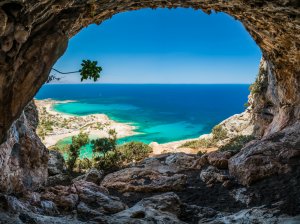The super blue blood moon has come and gone, and there won’t be another one for 20 years. But there are plenty of other natural phenomena you can see that occur often enough to plan a trip around.
A tropical permafrost lake
Lake Waiau sits at about 13,000 feet of elevation near the summit of Mauna Kea on the island of Hawaii. It’s the only permafrost lake in the tropics, and though it shrank to about 2 percent of its previous size several years, it has made a comeback and can be reached by hike off the road to Mauna Kea’s summit. On the same island, you can also visit a Papakolea Beach, which features green sand thanks to a large supply of the mineral olivine. On clear days, you might also catch a glimpse of a green flash across the horizon just as the last rays of the sun go down, a special sight owing to the island’s latitude. Also on the Big Island, where Kilauea Volcno has been erupting continuously for 35 years, you can see thin strands of volcanic glass known as Pele’s hair, named after the goddess of fire.
Rainbow eucalyptus
Native to parts of the Philippines, Indonesia and New Guinea, this multicolored tree is the only eucalyptus whose natural range extends into the Northern Hemisphere. The trees periodically shed bark, revealing a green inner bark, which changes color over time to blue, purple, orange and maroon. In their natural environments, which are rainy tropical forests, the trees can grow to be more than 200 feet tall. Though they have been imported to several U.S. states, rainbow eucalyptus are at their tallest and most colorful in their natural settings.
Aurora Borealis/Australis
Go far enough north or south, and eventually you’ll see brightly colored light particles dancing through Earth’s magnetic shield. The best time to see them, of course, is winter, when the sky is dark most of the time. Closer to home, Alaska and northern Canada are great places to spot them, while Europe’s Nordic countries, especially Norway, Sweden and Finland offer great vantage points. The southern version, Aurora Australis, is more difficult to spot because of the remoteness of Antarctica, but from New Zealand’s South Island, Tasmania and the island of South Georgia, the lights do make occasional appearances in the night sky.
Bioluminescent bays
Puerto Rico is home to three bioluminescent bays, which light up at night thanks to the presence of dinoflagellates in the water. There were fears that Hurricane Maria could have altered the shape of the bays enough to end the nightly show. Fortunately, that has not happened. The brightest of the three is Mosquito Bay off the island of Vieques, and all three are great for kayaking and are best seen during a new moon when the sky provides a dark backdrop.
Basalt towers
Formed by an ancient volcanic eruption, the pillars of rock that form Giant’s Causeway in Northern Ireland’s County Antrim stand as sentinels along the coast overlooking the North Channel. Legend has it the giant Finn MacCool built the causeway to cross over to Scotland and fight a rival giant. The tallest columns are almost 40 feet high and the cliffs are nearly 100 feet thick in spots. After a visit, head just a few miles down the road to the Bushmills Distillery, where you can have a whiskey tasting and tell your own tales of fighting giants.







